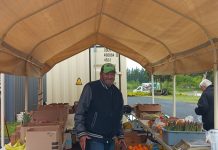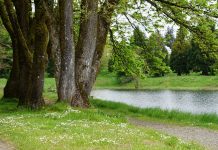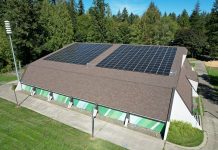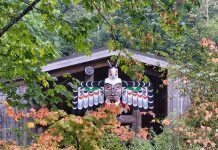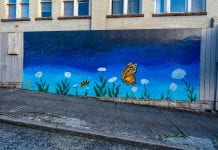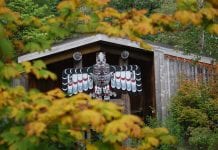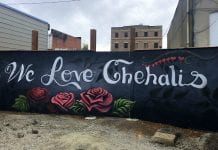Stretching 23 miles in length with 52 miles of shoreline, Lewis County’s Riffe Lake is one of the many recreation destinations in our region. For many, this is the spot where fishing turns into a lifelong obsession, with anglers of all ages and abilities catching smallmouth bass, landlocked salmon and brown trout. For many, Riffe Lake was where we learned to  fish, where we spent warm summer days and what we drove past on summer adventures up to Mount Rainier, Mount Saint Helens and Mount Adams. It was where some of us learned to swim and where most of us bonded with the waters and forests of the Pacific Northwest. For nearly 50 years, dipping your lines into this lake has been a rite of passage for locals, but it wasn’t always this way. Lurking under this iconic Pacific Northwest lake is a history and past that deserves to be remembered.
fish, where we spent warm summer days and what we drove past on summer adventures up to Mount Rainier, Mount Saint Helens and Mount Adams. It was where some of us learned to swim and where most of us bonded with the waters and forests of the Pacific Northwest. For nearly 50 years, dipping your lines into this lake has been a rite of passage for locals, but it wasn’t always this way. Lurking under this iconic Pacific Northwest lake is a history and past that deserves to be remembered.
The region around Riffe Lake has been historically important for the better part of a century. The lake was named after a small pioneering community that was covered when the lake was formed. In fact, three towns no longer in existence once lined the Cowlitz River where present-day Riffe Lake is now, including the city of Kosmos.
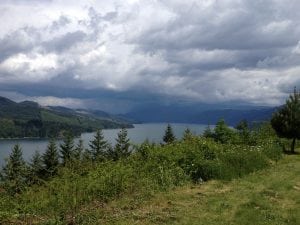
The town of Kosmos, pronounced as Caws-Muss, was located on the Cowlitz River and the area was known for its natural beauty. The river was full of salmon, lined with towering trees, meandering down a series of box canyons that offered world-class vistas of this wild river. Around 35,000 years ago, the Cowlitz and Ingraham glaciers stretched over 60 miles down from Mount Rainier, forming the canyons and molding the hills around the river. In the early 1900s, the river was as wild as anything in America, getting more and more full of untouched wilderness the closer you got to the flanks of the iconic Mount Rainier. It was for that reason that the region become a haven for the lumber industry, with trees nearly the length of football fields occasionally being paraded through town after they were cut down. All along the river, small lumber towns popped up, supported by the seemingly endless supply of lumber.
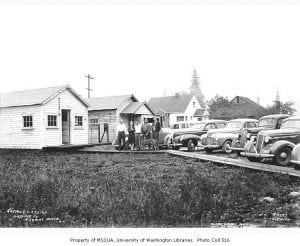
One of those towns was Kosmos, which was established in 1904, a few years after the city of Riffe was founded. During its heyday as a logging town, the city had anywhere between 150 and 500 residents, mainly consisting of loggers and those who supported the timber industry. For nearly 64 years, the main industry in town was the Kosmos Timber Company Mill, which helped process the massive trees taken down all around the region. Like the towns of Morton and Randle, great pride was taken with the lumbermen of the town, completely defining the region as a place for tough people to work hard out in the majesty of the Pacific Northwest. The town wasn’t large and really had very little in terms of the modern amenities of its day. Up until the very end of the town, it had just a handful of buildings. Made up of houses, a store, a post office, a recreation hall and a tavern, Kosmos was a byproduct of the lumber boom.
Kosmos had its very own celebrity back in the late 50s and early 60s. An employee at the Kosmos Timber Company Mill, Kenneth “Kelly” Stanley was once the world’s fastest tree climber. As a two-time World Champion High Climber in 1963 and 1964, he competed around the world even appearing on the TV show the “Wide World of Sports.” Just a few years before, Kelly was a featured act at the 1962 Seattle World’s Fair and at the 1967 Montreal World’s Fair. He passed away on January 4, 2016, at 82 years of age.
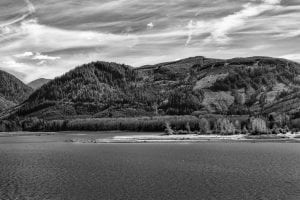
Once the dam was built, the mill that Kelly worked at was relocated to the nearby town of Morton. The mill took over farmland in Morton, where it became another place of employment for locals, helping define the region and its people. Today, the mill has closed and like the town of Kosmos, its memories and legacy are remembered only by a few.
Kosmos, which was found south of Mount Rainier and north of Mount Saint Helens, was initially supposed to become lakefront property after the Mossyrock Dam was scheduled to be built. Before the dam was completed, the desire for more hydroelectricity for Puget Sound forced the dam to be larger than originally planned. The rising dam and water forced the 500 residents of Kosmos to pack up and move to nearby towns. The year before the water level was supposed to reach the town, everyone had left, allowing for the Army Corps of Engineers to raze the town’s buildings and tear down the bridges. By 1968, the dam was completed and the town was under the glacial-fed waters.
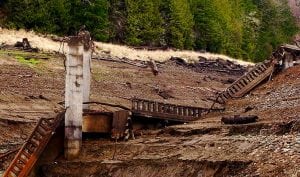
Today, Riffe Lake offers a chance to float above the once-proud lumber towns. As we fish, swim and boat around the waters, few of us take the time to remember what use to be located along the now flooded riverbed below. Vibrant towns vanished, leaving memories of Cosmos and Riffe a thing of the past. Luckily, each summer, as the river runs low and the dam pumps more water, remnants of Kosmos can be seen. The remains of the Steffen Creek Bridge on the show where the Cowlitz River once ran near Kosmos stand out on the muddy banks, as the concrete foundations of the town’s few buildings. On those warm summer days of low water, Kosmos is once again remembered and stories of the town are told by old-timers.
This is where livelihoods were found. This is where people homesteaded those rivers, and this is where locals helped build the reputation and nickname of Washington, the Evergreen State.






